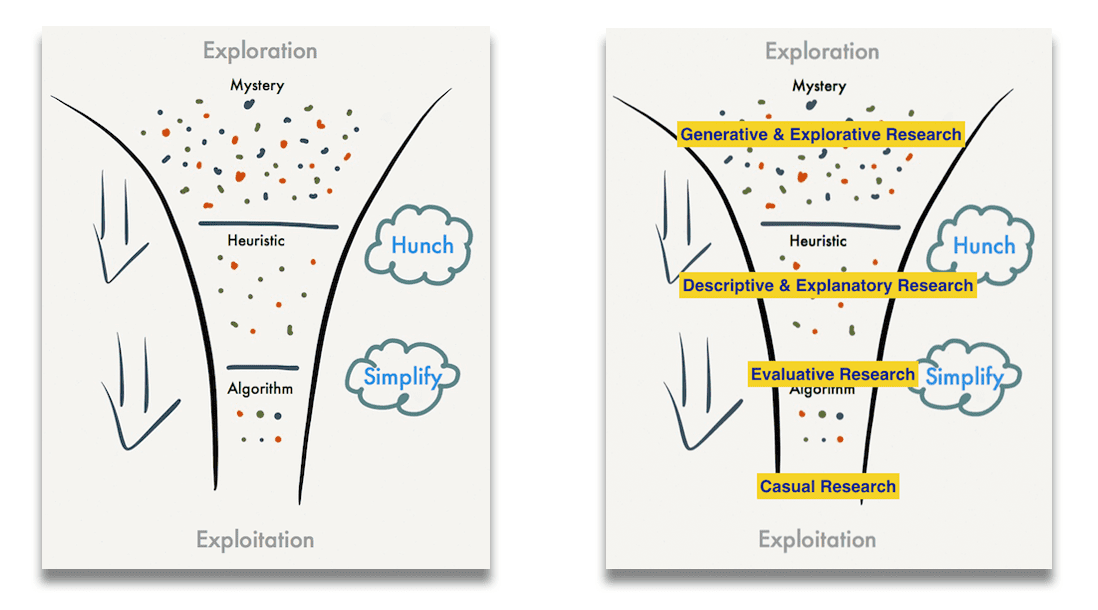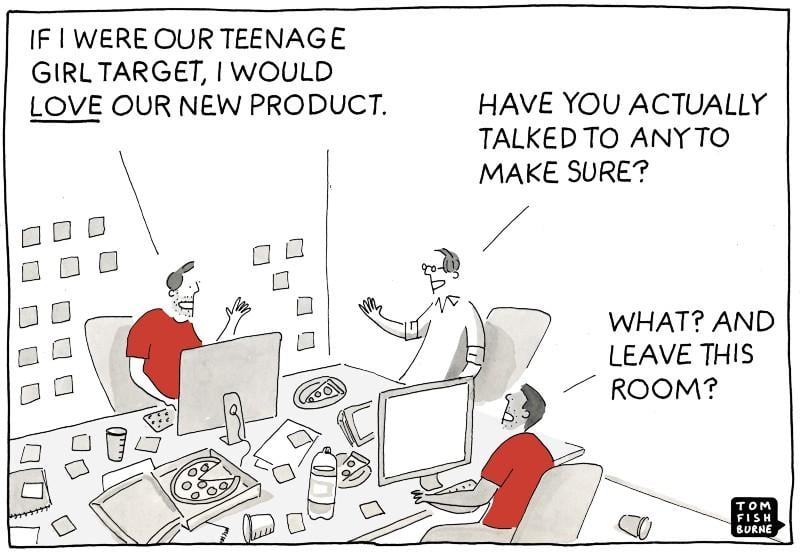Kundenbefragungen sind das Tor zur Stimme des Kunden (VOC). Doch trotz dieser wertvollen Geschäftseinblicke ist die Durchführung von Kundeninterviews oft ein Schattendasein, wobei die Praktiken von Unternehmen zu Unternehmen und von Team zu Team stark variieren. Bei tl;dv habe ich meine Erfahrungen im Bereich customer success gebündelt, unter anderem in Positionen wie Head of Customer Success, Head of Customer Experience und Director of Customer Success. Durch diese Erfahrungen habe ich aus erster Hand erfahren, welche Auswirkungen eine solide Strategie für customer success nicht nur auf die Leistung der kundenorientierten Teams hat, sondern auch auf die Bottom-up-Effekte, die sich auf andere Abteilungen übertragen.
Ich führe Sie durch meine bewährten Kundeninterview-Fragen, die über die oberflächlichen Kundenpräferenzen hinausgehen, um zu den Kernmotivationen der Kunden zu gelangen. Ich werde Ihnen auch einige meiner geheimen customer success Hacks zeigen.
Wir hören auf unsere Nutzer und Kunden hier bei tl;dv. Wir wollen keine Vorfälle wie den folgenden....
@tldv.io Keine Sorge, es war versichert. #benutzerforschung #tech #startup #ceo #uxdesign #uxresearch
♬ Originalton - tldv.io - KI-Meeting-Recorder
Verschiedene Arten von Kundengesprächen

Wenn ich meine Kundeninterviews durchführe, lehne ich mich gerne an einige Prinzipien aus UX- und Produktdesign-Benutzerinterviews an.
Einer meiner Lieblingsrahmen, der manchmal als Leitfaden für ein Kundeninterview und die von mir gewählten Fragen dienen kann, ist der "Wissenstrichter" von Roger L. Martin, der oft in Benutzerinterviews eingebettet wird.
Dieser Wissenstrichter beschreibt im Wesentlichen die verschiedenen Stufen, die das "Wissen" von der "Ahnung" bis zur bestätigten Hypothese durchläuft. In früheren Phasen können Kundenbefragungen durchgeführt werden, um Informationen zu sammeln und daraus Vermutungen abzuleiten, die dann mit weiteren Tests und Kundenbefragungen weiter untersucht und validiert werden können.
Kundeninterviews zur Erkundung
Sondierungsgespräche dienen dazu, die Gedanken und Gefühle eines Kunden außerhalb des Produktkontextes zu erfahren. Es ist eine Methode, um die Personen, Systeme und Güter zu verstehen, mit denen die Kunden zu tun haben, um ihre Aufgabe(n) zu erfüllen. Sie sollten besonders darauf achten, den Kunden nicht auf Ihre Marke als Heilmittel zu verweisen, sondern herauszufinden, welche Herausforderungen er hat, wie er sie bewältigt und ob sein Bedarf ein eigenständiges Produkt oder eine Lösung erfordert. Dieser Interviewtyp wird am besten in früheren Phasen des Wissenstrichters eingesetzt, um Vermutungen und Bereiche für weitere Untersuchungen und Kundenbefragungen zu ermitteln. Das Ziel kann dabei recht offen sein, z. B. die Entdeckung neuer Geschäftsmöglichkeiten, die Suche nach Wegen zur Erhöhung der Kundenbindung oder die Verbesserung des Kundendienstes.
Kundenbefragungen zur Validierung
Sie werden eine Hypothese darüber entwickeln, wie Sie Ihre Kunden bei ihren Problemen unterstützen können, sobald Sie deren Probleme verstanden haben. Validierungsinterviews helfen uns, ein bestimmtes Kundenproblem einzugrenzen.
Diese Art von Kundeninterview passt in die Mitte bis zum Ende des "Wissenstrichters". Sie haben eine Idee und eine Vermutung. Sie haben diese Idee mit Nutzer- und Kundenbefragungen weiter getestet. Nun hat das Unternehmen ein MVP oder eine Produktfunktion entwickelt, die das Anliegen des Kunden (Hypothese) aufgreift. Dieses Kundeninterview dient dazu, diese Hypothese zu testen, um sie weiter zu skalieren oder neu zu bewerten.
Kundeninterviews für Effizienz
Effizienzbefragungen zielen darauf ab, Ineffizienzen in den Benutzerabläufen zu ermitteln. Für jede Produktfunktion, die Ihr Unternehmen anbietet, müssen Sie beobachten, wie Ihre Kunden sie nutzen. Auf diese Weise können Sie sich wiederholende oder irreführende Abläufe ermitteln, die Sie mit einer Produktaktualisierung beheben können. Wenn Ihr Produkt zu verwirrend oder kompliziert ist, werden sich die Kunden abwenden. Wenn Sie alle Benutzerströme mit diesen Interviews abdecken wollen, sollten Sie die hochwertigen Kanäle hervorheben und sie gründlich testen.
Diese Art der Kundenbefragung dient dazu, Erkenntnisse zu gewinnen, die sich positiv auf die Kundenbindung und das Kundenengagement auswirken.
Beispiele für Fragen im Kundengespräch
Die besten Fragen im Vorstellungsgespräch sind die, die nicht auf den Punkt kommen, sondern nachfragen. Damit meine ich, dass es wichtig ist, zum Kern einer jeden Frage vorzudringen.
Stellen Sie keine Vermutungen darüber an, warum ein Kunde Ihnen eine Antwort oder eine Vorliebe gegeben hat. Fragen Sie!
Wenn Sie jedoch versuchen, der Wahrnehmung, den Vorlieben oder der Motivation eines Kunden auf den Grund zu gehen, sollten Sie ihn nicht zu einer bestimmten Schlussfolgerung verleiten. Hier sind einige meiner Lieblingsfragen für Kundengespräche:
Fragen zur Kundenbefragung zur Identifizierung eines Problems oder einer Marktlücke
- Was könnte geändert werden, um [Prozess/Rolle] zu einer besseren Erfahrung für Sie zu machen?
- Was ist das Schwierigste an der Tätigkeit als [demografische Gruppe]?
- Was sind Ihre unerfüllten Bedürfnisse?
- Was ist der schwierigste Aspekt Ihres Tages?
- Welche Ware würden Sie sich wünschen, die es nicht gibt?
- Welche Tätigkeiten nehmen die meiste Zeit Ihres Tages in Anspruch?
Interviewfragen mit Kunden zur Produktfindung
- Was ist die größte Herausforderung bei [dem Projekt, an dem Sie gerade arbeiten]?
- Was tun Sie gerade, um dieses Problem zu lösen/ diesen Wert zu erlangen?
- Woran erkennen Sie, dass Sie ein erfolgreiches Jahr/Monat/Tag hinter sich haben? Was gefällt Ihnen an [Konkurrenzprodukt oder -dienstleistung], und was gefällt Ihnen nicht?
- Wie sähe es aus, wenn Sie irgendwie einen Zauberstab schwingen könnten und eine Lösung für dieses Problem hätten?
Interviewfragen mit Kunden zur Produktfindung
- Was ist die größte Herausforderung bei [dem Projekt, an dem Sie gerade arbeiten]?
- Was tun Sie gerade, um dieses Problem zu lösen/ diesen Wert zu erlangen?
- Woran erkennen Sie, dass Sie ein erfolgreiches Jahr/Monat/Tag hinter sich haben?
- Was gefällt Ihnen an [Konkurrenzprodukt oder -dienstleistung], und was gefällt Ihnen nicht?
- Wie sähe es aus, wenn Sie irgendwie einen Zauberstab schwingen könnten und eine Lösung für dieses Problem hätten?
Kundeninterviews zur Produktverbesserung
- Was würden Sie gerne tun, was Sie heute nicht tun können?
- Was kann getan werden, um dieses Produkt zu verbessern?
- Was ist der schwierigste Aspekt bei der Verwendung dieses Produkts?
- Warum möchten Sie dieses Produkt weiterhin verwenden?
- Was reizt Sie an dieser Ware am meisten?
- Was ist das Besondere an dieser Ware, dass Sie Ihren Freunden davon erzählen wollen?
GPT-Aufforderungen zum Kundengespräch
Während die obige Auswahl einen breiten und aufschlussreichen Einblick in die Präferenzen und Bedürfnisse der Kunden gibt, kann GPT helfen, detailliertere Antworten und Gefühle intern aufzudecken, bevor Sie überhaupt zum Abschnitt der Kundenbefragung kommen. Durch den Einsatz von GPT-gesteuerten Tools wie ChatGPT können Sie neue Blickwinkel und Einblicke gewinnen, um Kundeninterviews voranzutreiben.
Einige Ideen für Anregungen, die Ihnen den Einstieg erleichtern, sind:
- Was sind mögliche Annahmen über unsere Kunden und ihre Bedürfnisse?
- Welche Informationen haben wir bereits über unsere Kunden?
- Was sind die wichtigsten Herausforderungen oder Probleme, mit denen unsere Kunden in unserer Branche konfrontiert sind?
- Wie können wir die Erkenntnisse unserer Kunden nutzen, um unser Produkt oder unsere Dienstleistung zu verbessern?
- Wie interagieren unsere Kunden mit unserem Produkt oder unserer Dienstleistung?
- Was sind die wichtigsten Beweggründe für unsere Kunden, unser Produkt oder unsere Dienstleistung zu nutzen?
- Was sind die wichtigsten Einwände oder Hindernisse, die Kunden davon abhalten, unser Produkt oder unsere Dienstleistung zu nutzen?
- Wie können wir die Verhaltensweisen und Vorlieben unserer Kunden besser verstehen?
- Wie können wir die Erkenntnisse über unsere Kunden nutzen, um uns von unseren Mitbewerbern zu unterscheiden?
Meine persönlichen Tipps und Tricks für ein erfolgreiches Kundengespräch

Jeder wird seine eigene Methode zur Durchführung von Kundenbefragungen haben. Das ist gut so. Es ist jedoch wichtig, dass alle Kundengespräche mit einem Plan und einem Ziel beginnen.
Abgesehen von den grundlegenden Dingen wie Vorbereitung, Aufzeichnung von Kundengesprächen mit einem Tool wie tl;dv und einem sympathischen Auftreten, möchte ich Ihnen hier einige meiner geheimen Tricks vorstellen, mit denen Sie Kundengespräche gewinnen und die besten Fragen für Kundengespräche auswählen können.
Erstens müssen wir diese immer im Hinterkopf behalten:
- Aufbau einer Beziehung zu den Kunden (um Vertrauen aufzubauen, damit sie sich öffnen).
- Effizientes Zuhören (um wirklich zu verstehen, was sie sagen) ist eine Fähigkeit, die man lernen kann.
- Aufzeichnung Ihrer Sitzungen.
- Haben Sie einen Spielplan.
- Teilen Sie Ihre Interviews.
- Seien Sie still und hören Sie zu.
- Stellen Sie keine Suggestivfragen.
- Lernen Sie Ihre Kunden im Vorfeld kennen
- Stellen Sie "detaillierte Fragen", um besser zu verstehen, was sie denken und fühlen.
Magst du mich?
Es ist nicht nötig, dies näher zu erläutern.
Wir alle wissen, dass der Aufbau von Beziehungen das Wichtigste ist, was man bei einem Kundengespräch tun kann.
So naheliegend dies auch ist, kann es aufgrund seiner überragenden Bedeutung für die Arbeit nicht von dieser Liste gestrichen werden.
In Kundengesprächen kann dies unter anderem folgendermaßen geschehen:
Spiegeln, nach der korrekten Aussprache des Namens fragen, Witze machen, das Gespräch leiten (Menschen mögen keine Überraschungen, lassen Sie sie wissen, was sie erwartet), und respektvoll mit ihrer Zeit umgehen.
Grundsätzlich sollten alle Eigenschaften und Verhaltensweisen, die für einen guten Menschen erforderlich sind, auf Ihre Kundengespräche übertragen werden.
Hier sind einige weitere vernünftige Tipps und Tricks von SneakerHead VC.

Einen Spielplan haben
Die Ziele, die Sie sich setzen, sollten klar sein und die Art des Kundengesprächs bestimmen, das Sie führen. Seien Sie sich mit dem Befragten über die Ziele des Gesprächs im Klaren. Geht es beispielsweise darum, Einblicke in die Nutzung eines Produkts durch den Kunden zu erhalten, oder möchten Sie detaillierte Informationen über die Probleme des Kunden erfahren? Kommunizieren Sie dies im Vorfeld und während des Kundengesprächs.
Nicht alle Ziele müssen mit dem Kunden kommuniziert werden. Werden Sie zum Beispiel Ihre Erkenntnisse in Ihren zweiwöchentlichen Produkt-Synchronisationen mitcustomer success teilen? Benötigen Sie vor der Markteinführung im nächsten Frühjahr mehr Feedback zu einer bestimmten Produktfunktion? Dies sind wichtige Fragen, die Sie sich vor dem Gespräch stellen sollten und die wahrscheinlich intern bleiben sollten.
Verlassen Sie sich nicht auf Ihr Gedächtnis
Gesprächsnotizen und -abschriften müssen nach dem Gespräch zu einer Sammlung von eindeutigen Kundenwünschen zusammengestellt und verdichtet werden. Einfacher geht es jedoch, wenn Sie Kundengespräche aufzeichnen. Das ist schneller, effizienter und schwer zu vergessen.
Ich persönlich verwende tl;dv , um alle unsere Kundengespräche aufzuzeichnen. Das kann die Aufzeichnung auf Zoom oder auf Google Meet sein, beide sind mit dem Tool kompatibel. Die Möglichkeit, Lesezeichen zu setzen, zu teilen, zu speichern und natürlich unsere Kundeninterviews auf den Meeting-Plattformen aufzuzeichnen, mit denen sie vertraut sind, war für mich ein entscheidender Vorteil. Lassen Sie mich noch einmal kurz auf die "Lesezeichen" zu sprechen kommen. Dabei handelt es sich im Wesentlichen um mit Zeitstempeln versehene Lesezeichen, die es mir und meinen Teamkollegen ermöglichen, schnell durch jede Aufzeichnung (ob lang oder kurz) zu navigieren und direkt zum relevanten Teil zu gelangen. Das ist eine echte Zeitersparnis!
Mit der Entwicklung von KI und GPT-gesteuerten Tools gibt es jetzt auch die Möglichkeit, "intelligente" Erkenntnisse zu nutzen. Mit tl;dv können Sie in Ihrem Online-Repository nach einem Stichwort suchen, und tl;dv stellt eine reel der Erwähnungen dieses Stichworts zusammen. Zusammen mit automatischer Sprechererkennung, Transkription (in mehr als 20 Sprachen) und mehr ist tl;dv der ultimative KI-Meeting-Assistent für Kundeninterviews und Nutzerforschung.
Klappe halten und zuhören
Wenn Sie mehr reden als Ihre Kunden, ist das ein Problem. Manchmal kann es verlockend sein, sich einzumischen, entweder mit Folgefragen, mit Korrekturen in Bezug auf das Produkt oder mit dem Versuch, zu helfen und die Sätze zu beenden. Sie erhalten viel mehr Einblicke, wenn Sie das nicht tun. Also mischen Sie sich nicht ein!
Stellen Sie keine Suggestivfragen

Eine Gruppe von Personen sah sich einen Film über einen "Autounfall" an und wurde gebeten, die Geschwindigkeit zu schätzen, mit der das Fahrzeug unterwegs war, als die Autos "zusammenstießen". Die Antworten der Befragten variierten um 9 m/h (14,5 km/h). Die einzige Variable, die geändert wurde und die den Teilnehmern so unterschiedliche Geschwindigkeitsschätzungen entlockte, war das Verb, das zur Beschreibung des Unfalls verwendet wurde. Wie aus dem obigen Diagramm hervorgeht, beeinflussten Wörter, die das Gefühl eines schwereren Zusammenstoßes hervorrufen, die Geschwindigkeitseinschätzung der Teilnehmer. Bei diesem Experiment handelte es sich um die Studie von Loftus und Palmer (1974) zur Beeinflussung von Augenzeugenaussagen und deren Erinnerungen durch die Sprache. Dieser Test veranschaulicht, wie leicht die Antworten von Menschen durch die Art und Weise, wie sie formuliert, gefragt oder vorbereitet werden, beeinflusst werden können. Es gibt zahlreiche Studien und Experimente, die die Macht der Sprache über Wahrnehmung und Verhalten belegen. Daher ist es sehr wichtig, dass Sie keine Suggestivfragen stellen, die eine Hypothese bestätigen, die Sie bestätigt haben möchten. Halten Sie Ihre Fragen lieber neutral.
Lernen Sie Ihren Kunden im Vorfeld kennen
Erfahren Sie mehr über ihren Hintergrund. Finden Sie ein gemeinsames Interesse oder sogar ein gemeinsames Lieblingsärgernis. Das ist ein großartiger Eisbrecher, um eine Beziehung aufzubauen. Ich bin der festen Überzeugung, dass ein Kunde ein Kumpel ist. Sie versuchen, etwas über seine Erfahrungen zu erfahren, um Ihr Produkt zu verbessern, aber vor allem, um ihm das Leben leichter zu machen.
Teilen Sie Ihre Interviews
Teilen ist heilsam. Hier bei tl;dv zeichnen wir unsere Kundeninterviews immer mit tl;dv auf und geben sie dann problemlos abteilungsübergreifend weiter.
Marketing, das Gründerteam, das Produkt - alle erhalten Zugang zu den Erkenntnissen! Dies ist eine Möglichkeit, den Wert unserer Kundenbefragung zu steigern. Durch die Ausweitung des Netzes von Erkenntnissen und Wahrnehmungen, die aus Kundeninterviews gewonnen werden, erweitern wir nicht nur die verwertbaren Erkenntnisse und die potenzielle Richtung für weitere Forschung, sondern auch andere Abteilungen werden durch die Erkenntnisse aus diesen Kundeninterviews bereichert.
Wie lässt sich das in der realen Welt umsetzen?
Ich gebe meine Kundeninterviews oft an das gesamte Team weiter. Produktmanager lieben es, unseren Kunden direkt zuzuhören, da dies ihre Produkt- und UX-Entscheidungen und -Überlegungen beeinflusst. Das Marketing hört sich die Erkenntnisse gerne an, da sie sich auf das Verständnis der Kunden auswirken und darauf, wie man sie am besten erreicht. Es gibt zahlreiche Disziplinen innerhalb eines Unternehmens, die davon profitieren können, ein Kundeninterview zu sehen und zu hören, anstatt die Interviewnotizen zu überfliegen.
Abschließende Überlegungen zu Fragen im Kundengespräch
Die Daten, die Sie bei Ihrem nächsten Kundengespräch sammeln, können Ihnen helfen, Ihr Produkt zum bestmöglichen MVP zu machen. Durch effektive Fragen in Kundeninterviews erfahren Sie, welche Zielmärkte wichtig sind und welche nicht, und auch, wofür die Kunden zahlen würden und was vielleicht nicht so gut ankommt. Ein gutes Kundeninterview ist für jedes Unternehmen von unschätzbarem Wert, wenn es richtig vorbereitet und strategisch geplant wird.














